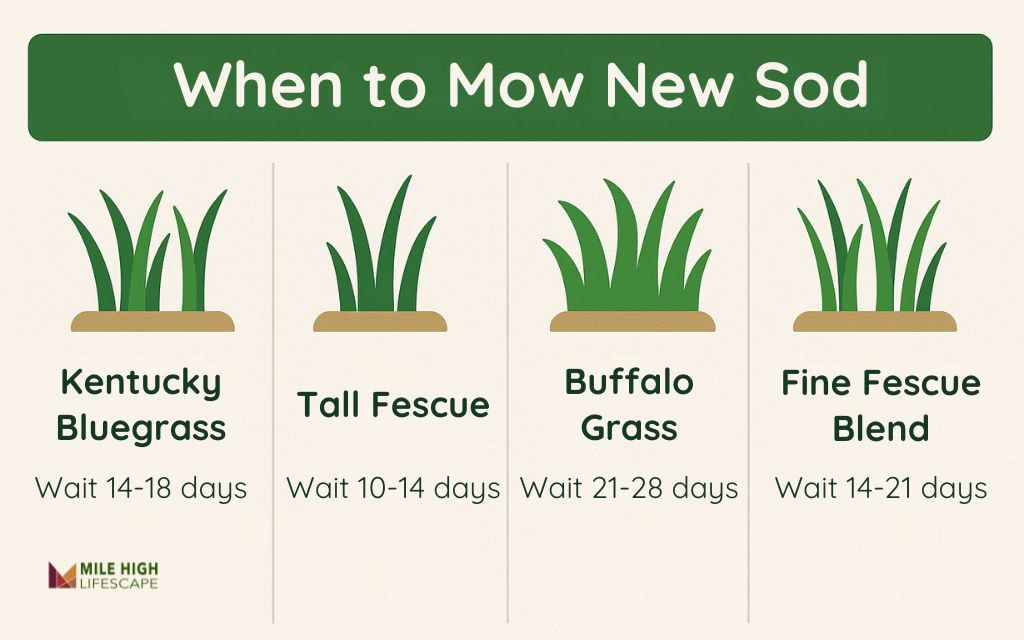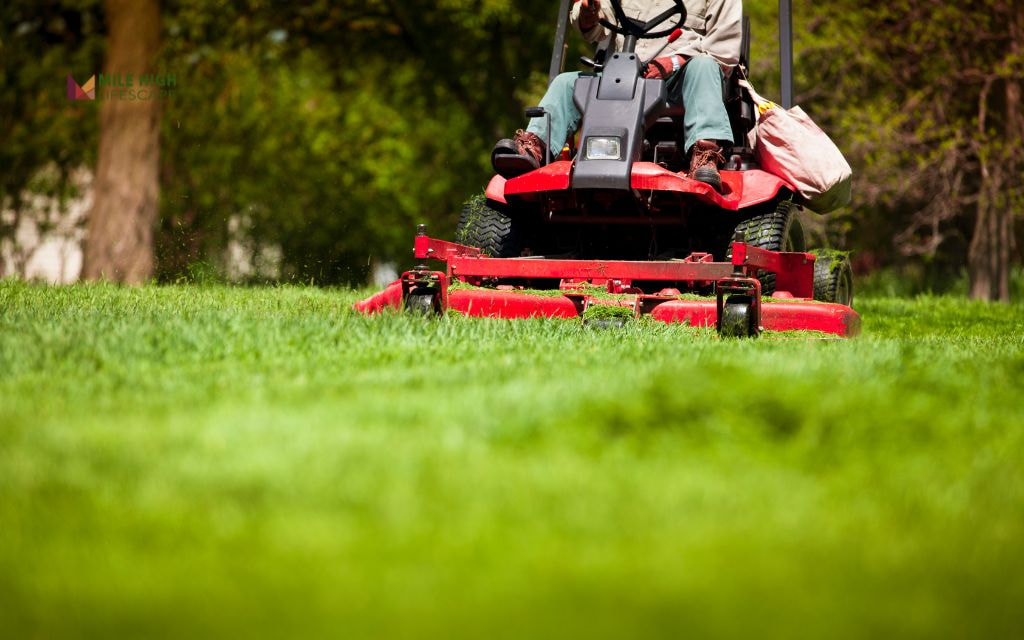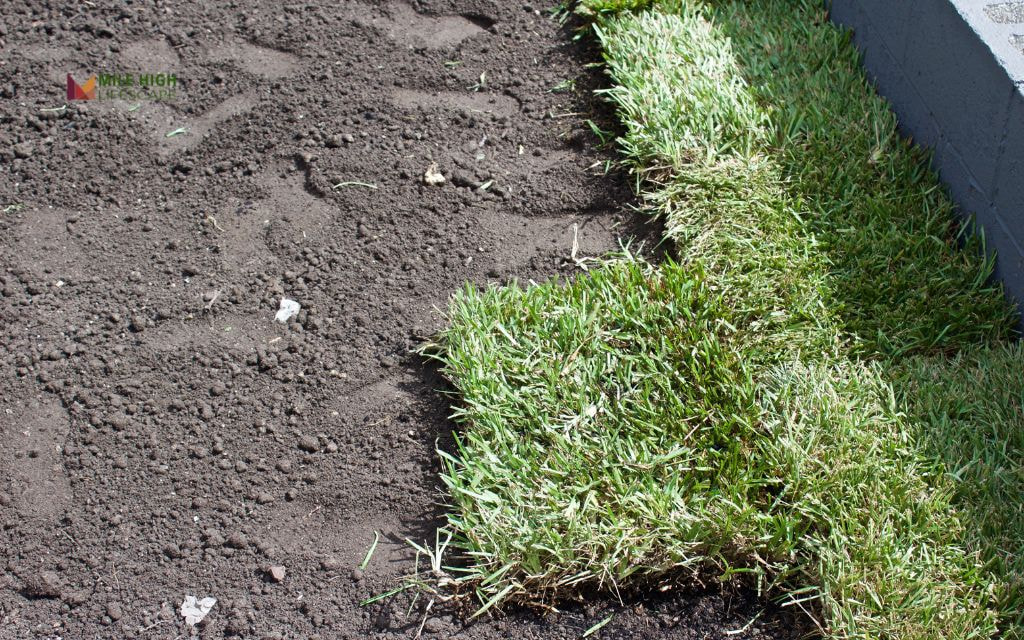“When to mow new sod?” Wait at least 2-3 weeks after installation, or until the roots have firmly established in the soil. You can verify readiness with a gentle tug test – if the sod lifts easily, it needs more time to develop strong roots.
Mowing too early risks significant damage to your investment. Premature cutting can tear the sod from the soil, disrupt root development, and create lasting bare patches.
This guide from Mile High Lifescape covers everything Denver homeowners need for that crucial first cut: optimal timing based on grass type, methods to check root establishment, proper mowing techniques, and essential aftercare to support your lawn’s long-term health.
When to Mow New Sod in Denver?
You should 2-3 weeks before the first mow, but also need to take into account Denver’s unique environment for a more nuanced approach. Our mile-high climate, intense sun exposure, and soil conditions all influence root development speed.
Different sod varieties establish at varying rates in our Colorado conditions:
| Sod Type | Minimum Wait Time | Optimal Conditions |
| Kentucky Bluegrass | 14-18 days | Most common in Denver, adapts well to our climate |
| Tall Fescue | 10-14 days | Establishes faster due to deeper initial rooting |
| Buffalo Grass | 21-28 days | Native grass requires more time but offers drought resistance |
| Fine Fescue Blend | 14-21 days | Good for partially shaded Denver yards |
Denver’s elevation affects how quickly roots develop. Thinner atmosphere means more intense sunlight that can stress new sod, while clay-heavy soils sometimes slow water penetration and root growth.
Proper irrigation becomes critical – too much water creates soggy conditions that delay rooting, while too little leads to drought stress and slower establishment.
Monitor weather patterns during your waiting period. Cool spring temperatures may extend your wait time to 3+ weeks, while summer installations might root faster if properly watered.

How to Ensure Your New Lawn Has Rooted Before Mowing?
Understanding the rooting process helps determine the right time for that first mow. New sod begins developing root connections within days, but complete establishment takes 1-3 weeks depending on conditions.
Test for proper root establishment using these reliable methods:
- Corner test: Gently lift a corner of the sod in different areas of your lawn (gentle tug test). If it resists lifting and you feel substantial tension, roots have begun establishing. If it lifts easily without resistance, wait longer.
- Walking test: Step carefully across your new lawn. The ground should feel firm and solid, not spongy or shifting. Your footprints shouldn’t create depressions or cause the sod to separate.
- Growth check: Measure your grass height. When it reaches 3.5-4 inches, the roots have typically developed enough to support mowing.
Check this guide to explore more about ways to care for your sod.
Preparing Your Lawn for the First Mow
Proper preparation prevents damage during that critical first cut:
- Schedule your mowing when the grass is dry – never cut wet sod.
- Moisture weakens the grass blades and creates clumping that results in uneven cuts. In Denver, wait until morning dew has evaporated, typically mid-morning.
- Ensure your mower blades remain sharp. Dull blades tear grass rather than cut it cleanly, creating entry points for disease and increasing stress on your new lawn. If you haven’t sharpened your blades recently, now is the time.
- Set your mower height to 3-3.5 inches for the first cut. This higher setting reduces stress while promoting deeper root development – especially important in Denver’s sometimes challenging growing conditions.
- Avoid using riding mowers for the first several cuts. Their weight can create ruts or depressions in newly rooted sod. Opt instead for a lightweight push mower that exerts minimal pressure on your developing lawn.
Before tackling the entire yard, test your setup on a small, inconspicuous corner. This allows you to verify your blade height and ensures the sod has rooted properly throughout the lawn.
How to Mow New Sod the Right Way?
The mowing technique you use matters as much as timing. Follow these professional practices for optimal results:
- Use the lightest equipment available for your first mow – preferably a push mower rather than a heavy self-propelled or riding model.
- Mow in straight, single passes across your lawn. Avoid tight turns that can stress or tear the sod, instead lifting the mower when you need to change direction.
- Follow the one-third rule: never remove more than one-third of the grass blade height in a single mowing. For new sod at 4 inches, cut to no lower than about 2.7 inches.
- If you’re collecting clippings, empty the bag frequently to maintain consistent suction and prevent clumping that might damage your new lawn.
- Time your mowing for cooler parts of the day – early morning after dew evaporates or evening after 6 PM. Denver’s midday sun can intensify stress on freshly cut grass.
- Watch for signs of stress like wilting or yellowing. If you notice these indicators, postpone mowing until conditions improve.
Establish a pattern of changing your mowing direction weekly from the start. This prevents soil compaction patterns and encourages upright growth, resulting in a more uniform, healthier lawn.

Aftercare: What to Do After the First Mow?
Your post-mowing routine establishes patterns for long-term lawn health.
- After that first cut, adjust your watering schedule – reduce frequency while increasing duration. This transition encourages deeper root growth.
- Instead of daily watering, shift to every other day with longer sessions that penetrate 3-4 inches into the soil.
- Wait at least two weeks after the first mow before applying fertilizer.
- When you do fertilize, choose a low-nitrogen, slow-release formula specifically designed for new lawns. This provides steady nutrition without the risk of burning tender roots.
Conduct thorough spot checks across your lawn, paying particular attention to:
- Edges where sod pieces meet
- Areas receiving full sun exposure
- Sections near concrete that heat up faster
- Low spots where water might pool
For your second mowing, wait until the grass reaches 3.5-4 inches again. This typically takes 5-7 days during the growing season in Denver. Maintain the same cutting height for the first 4-6 weeks to minimize stress while the root system continues developing.
Limit foot traffic and keep pets off newly mowed areas for at least 24 hours after cutting. This gives the grass time to recover from the stress of mowing.
Why Mowing New Sod Is Different from Mowing an Established Lawn?
New sod requires special care compared to established lawns for several fundamental reasons.
- Undeveloped root systems make new sod vulnerable to displacement, while established lawns have roots that penetrate deeply into the soil.
- Blade stress affects new sod more significantly since it hasn’t developed the resilience to recover quickly from cutting.
- Traffic sensitivity remains higher with new sod—even foot traffic can cause shifting or separation in areas where roots haven’t fully anchored.
- Water requirements differ substantially, with new sod needing consistent moisture to support root development, while established lawns benefit from deeper, less frequent watering.
Common Mistakes to Avoid
Prevent these frequent errors that compromise new sod establishment:
- Mowing wet sod: Causes tearing, rutting, and compaction that damages developing roots. Always wait for the lawn to dry completely.
- Cutting too short: “Scalping” removes too much leaf surface needed for photosynthesis, stunting root development.
- Using dull blades: Creates ragged cuts that increase water loss and disease susceptibility. Sharp blades make clean cuts that heal quickly.
- Ignoring visual cues: Relying solely on calendar days rather than testing for root establishment often leads to premature mowing.
- Neglecting irrigation adjustments: Failing to modify watering schedules after mowing can result in either drought stress or overwatering. Reduce frequency while increasing duration after the first mow.

Conclusion
The first mow represents a significant milestone in your new sod development. When done correctly, it stimulates lateral growth and encourages deeper rooting that prepares your lawn for Denver’s climate challenges.
Remember the essentials: wait at least 2 weeks, verify root establishment through resistance testing, mow at a higher setting with sharp blades, and adjust your care routine afterward to support continued development.
For homeowners seeking professional sod installation guidance or assistance, Mile High Lifescape offers comprehensive lawn care services tailored to Denver growing conditions. Contact us for a lawn assessment or maintenance plan that ensures your investment thrives for years to come.
Frequently Asked Questions (FAQs)
How long should you wait to mow new sod?
You should wait at least 14 days before mowing newly installed sod in Denver. This timeframe allows the roots to establish sufficient connection with the soil beneath. During hot summer months with ideal growing conditions, some varieties like Tall Fescue might establish faster, while Buffalo Grass typically requires 3-4 weeks minimum.
When should I stop watering new sod every day?
By the 3rd and 4th weeks, your new sod should be firmly rooted and ready for deeper, less frequent watering. At this stage, water your lawn every other day, soaking the soil to a depth of 3-4 inches. This transition encourages roots to grow downward, creating a more drought-resistant lawn.
How long does it take for sod to take root?
Sod takes 2 to 6 weeks to fully take root, with shallow roots developing within the first 10-14 days. Proper installation and maintenance can expedite this process, especially during warmer months.
How long does it take for sod lines to disappear?
Sod lines typically disappear within 3-4 weeks after installation when proper watering and fertilization protocols are followed. These seams become less visible after the first mowing as the grass begins to grow laterally. Complete blending can take up to 2 months in Denver’s climate, particularly during cooler seasons when growth slows.
Should I leave grass clippings on new sod?
No, you should remove clippings after the first few mowings of new sod. While clippings eventually benefit established lawns by returning nutrients to the soil, they can smother young grass and block crucial sunlight needed for development. After 4-6 weeks, when your lawn has fully established, you can begin returning clippings to the lawn as natural fertilizer.
